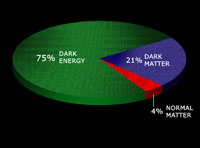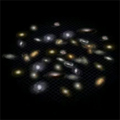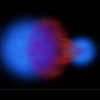An overview of the Chandra mission and goals, Chandra's namesake, top 10 facts.
Classroom activities, printable materials, interactive games & more.
Overview of X-ray Astronomy and X-ray sources: black holes to galaxy clusters.
All Chandra images released to the public listed by date & by category
Current Chandra press releases, status reports, interviews & biographies.
A collection of multimedia, illustrations & animations, a glossary, FAQ & more.
A collection of illustrations, animations and video.
Chandra discoveries in an audio/video format.
Bedeviling Devil's Advocate Cosmology
August 21, 2006 ::
In the last decade incredible progress has been made in finding answers to some of the most exciting questions in astronomy such as: what is the universe made of, how big is it, how did it begin and what is its future? Astronomers have also converged on a cosmology where "normal" matter, the material found in our bodies, the Earth and the stars makes up only a few percent of the universe. And, a vast majority of scientists agree that most of the matter in the universe is invisible -
dark matter - and consists of some kind of exotic particle that is yet to be discovered. Finally, the expansion of the universe since the Big Bang is speeding up because of an even more mysterious entity called
dark energy.
These results are so surprising that some astronomers who accept and even contribute to this work have called the universe "preposterous" or "extravagant." In the opposite camp is a small, but passionate, group of astronomers who think there are serious flaws in the currently accepted cosmology. Last year they organized the first "Crisis in Cosmology" conference, after sending an open letter to the world-wide scientific community in 2004 protesting the "stranglehold of Big Bang theory on cosmological research and funding." They also write books with eye-catching titles like "The Big Bang Never Happened".
Could this group of critics be right, at least partially? After all, well-established theories have been wrong before. What if there is a basic flaw in today's cosmology? Since cosmology involves such big questions, it's important to play devil's advocate and carefully check the key assumptions to see if they are as strong as they should be.
One key assumption is that gravity is consistent with the theories of Newton and Einstein. Some scientists have suggested changes to the theory of gravity which make it stronger than predicted by Newton and Einstein on intergalactic scales. The goal is to see if the need for dark matter can be eliminated. If dark matter doesn't really exist, then maybe a domino effect would occur with the rest of the theory. Other mysteries like dark energy might also go away and cosmology would have to be significantly revised.
Attempts to modify gravity have had some success when applied to the rotation of individual galaxies, potentially removing the need for dark matter in these objects. But these alternative theories of gravity have been less successful explaining the behavior of galaxy clusters. Despite these mixed results, some astronomers are attracted to the
idea of modifying gravity. For example, Vera Rubin, who pioneered the work on dark matter in galaxies said in New Scientist: "If I could have my pick, I would like to learn that Newton's laws must be modified in order to correctly describe gravitational interactions at large distances. That's more appealing than a universe filled with a new kind of sub-nuclear particle."
One way to decide between these competing theories - dark matter vs alternative gravity - is to find a system where the normal matter and the inferred dark matter are separated in space. Alternative gravity theories would be unable to explain such an arrangement. This is a tough assignment because gravity is very good at holding normal matter and dark matter together.
One possibility is that in a collision between two clusters of galaxies, the attraction between normal and dark matter can be temporarily overcome. Scientists can also take advantage of the fact that most of the normal matter in galaxy clusters is found in hot gas, rather than in stars and galaxies. In a collision between two clusters, the two huge gas balls can exert a drag force, similar to air resistance, on each other. In contrast, the dark matter should not slow down because it does not interact directly with itself or the gas except through gravity. This difference in behavior between normal and dark matter should cause them to separate.
A very powerful collision is needed to do this, and we also need a good side-on view so that the separation is clearly visible. This is what the bullet cluster gives us, a great view of the most energetic collision ever seen. Using NASA's Chandra X-ray Observatory, plus Hubble Space Telescope, the Magellan telescope and the ESO 2.2 m telescope, astronomers have seen a separation between normal and dark matter for the first time. Messing around with gravity to avoid dark matter cannot explain this result. The nature of dark matter is still a mystery, but this invisible stuff won't go away.







